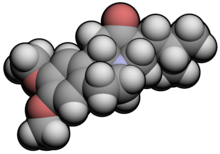
Back تيترابينازين Arabic تترابنازین AZB Tetrabenazin German Tetrabenazina Spanish تترابنازین Persian Tétrabénazine French Tetrabenazina Italian Tetrabenazinum Latin ଟେଟ୍ରାବେନାଜାଇନ OR Tetrabenazyna Polish
 | |
 | |
| Clinical data | |
|---|---|
| Trade names | Xenazine, Xentra, Nitoman, others |
| Other names | Ro-1-9569 |
| AHFS/Drugs.com | Consumer Drug Information |
| Pregnancy category |
|
| Routes of administration | By mouth |
| ATC code | |
| Legal status | |
| Legal status | |
| Pharmacokinetic data | |
| Bioavailability | Low, extensive first pass effect |
| Protein binding | 82–85% |
| Metabolism | Liver (CYP2D6-mediated) |
| Elimination half-life | 10 hours parent compound (2 to 8 hours active metabolites)[3] |
| Excretion | Kidney (~75%) and fecal (7–16%)[4] |
| Identifiers | |
| |
| CAS Number | |
| PubChem CID | |
| IUPHAR/BPS | |
| DrugBank | |
| ChemSpider | |
| UNII | |
| KEGG | |
| ChEMBL | |
| CompTox Dashboard (EPA) | |
| ECHA InfoCard | 100.000.348 |
| Chemical and physical data | |
| Formula | C19H27NO3 |
| Molar mass | 317.429 g·mol−1 |
| 3D model (JSmol) | |
| Chirality | Racemic mixture |
| |
| |
| (verify) | |
Tetrabenazine is a drug for the symptomatic treatment of hyperkinetic movement disorders. It is sold under the brand names Nitoman and Xenazine among others. On August 15, 2008, the U.S. Food and Drug Administration approved the use of tetrabenazine to treat chorea associated with Huntington's disease. Although other drugs had been used "off label," tetrabenazine was the first approved treatment for Huntington's disease in the U.S.[5] The compound has been known since the 1950s.
- ^ "TETRABENAZINE RAN/TETRABENAZINE SUN/TETRABENAZINE RBX (Sun Pharma ANZ Pty Ltd)". Therapeutic Goods Administration.
- ^ Anvisa (2023-03-31). "RDC Nº 784 - Listas de Substâncias Entorpecentes, Psicotrópicas, Precursoras e Outras sob Controle Especial" [Collegiate Board Resolution No. 784 - Lists of Narcotic, Psychotropic, Precursor, and Other Substances under Special Control] (in Brazilian Portuguese). Diário Oficial da União (published 2023-04-04). Archived from the original on 2023-08-03. Retrieved 2023-08-16.
- ^ Yero T, Rey JA (December 2008). "Tetrabenazine (Xenazine), An FDA-Approved Treatment Option For Huntington's Disease-Related Chorea". P & T. 33 (12): 690–694. PMC 2730806. PMID 19750050.
- ^ "Xenazine (tetrabenazine) Tablets, for Oral Use. Full Prescribing Information. Revised: 6/2015" (PDF). H. Lundbeck A/S. Retrieved 9 December 2015.
- ^ 1st US drug for Huntington's disease wins approval [dead link]